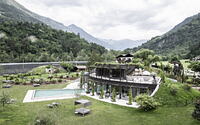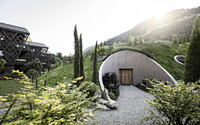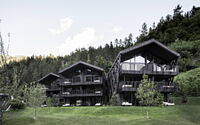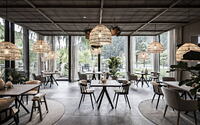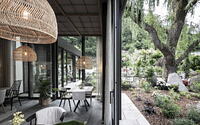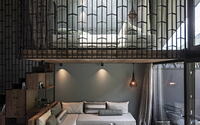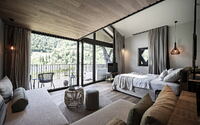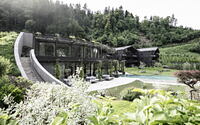Apfelhotel Torgglerhof by Noa* Network of Architecture
Discover the Apfelhotel Torgglerhof, a luxurious getaway nestled in the heart of the apple-filled valleys of Saltusio, Italy. Designed by the innovative Noa* Network of Architecture in 2020, this hotel embraces both the new and the old, encapsulating the rich history of the location while showcasing a fresh, modern design.
This masterpiece offers an exciting fusion of traditional roots with contemporary architecture, underlining the unique essence of the region’s apple cultivation culture. Whether it’s the hotel’s intricate architecture or the scenic views of the sprawling apple orchards, every aspect of the Apfelhotel Torgglerhof invites you to immerse yourself in a blend of rural charm and upscale luxury.

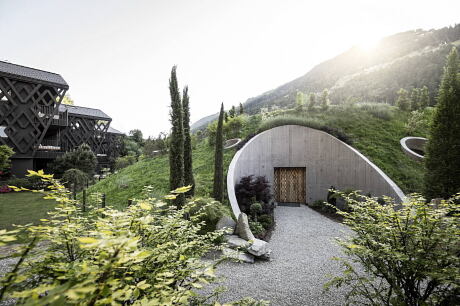
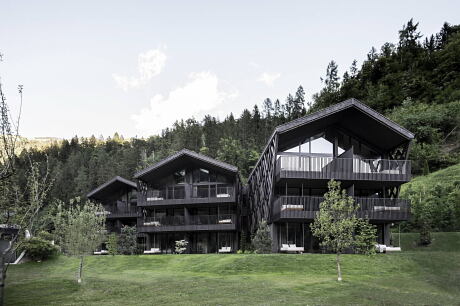
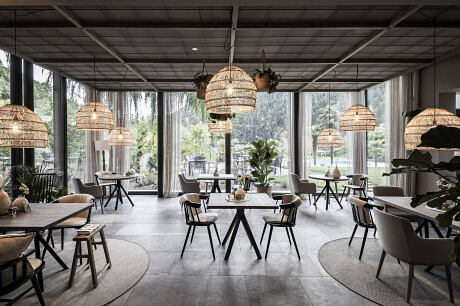
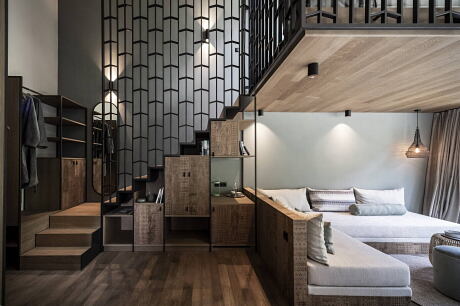
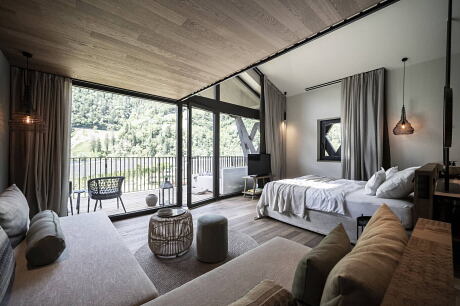
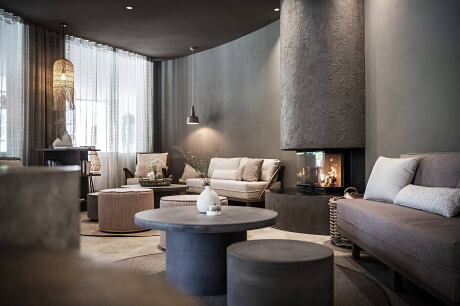

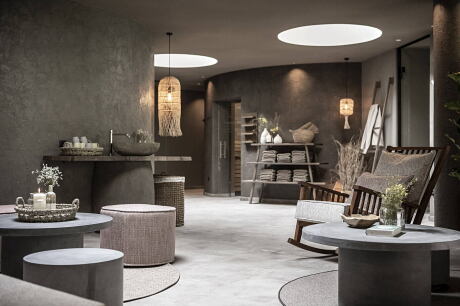

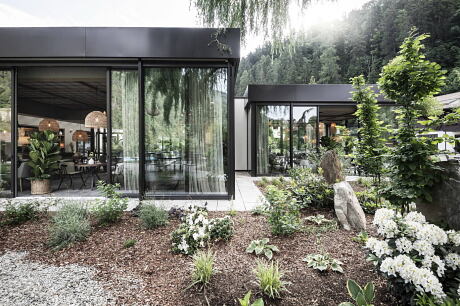

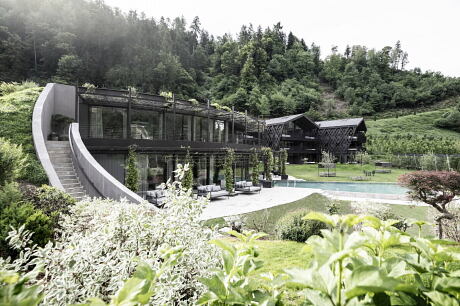
About Apfelhotel Torgglerhof
A New Generation: Revitalizing Tradition
In South Tyrol’s Saltaus, a new generation of owners at the Apfelhotel is breaking fresh ground while honoring their traditional roots. Through noa*’s innovative design and architecture, the vintage allure of this historic hotel is preserved, creating a sensory oasis and a hub for shared moments.
The apple, a fruit native to Kazakhstan and introduced to South Tyrol by the Romans, remains at the heart of the region’s cultural landscape. Rooted deep within the classic apple cultivation culture, the Torgglerhof, situated at the entrance to the Passeier Valley, has evolved into a place for people to connect, linger, and enjoy the picturesque vistas. This is where the Apfelhotel, also known as the Applehotel, emerged as both a popular destination and a hidden gem for guests seeking an exceptional holiday retreat, complete with exquisite architecture.
The Birth of a Vision
In 2014, noa* triumphed in a design competition to expand the hotel’s existing structure, a project carried out in multiple stages. By 2016, both the main building housing the restaurant and the old barn underwent reconstruction.
Hidden behind the barn’s original facade, beneath the guest rooms, lies the Apfelhotel’s production of various delicacies, made from their home-grown apples and other local specialties. The Apfelsauna, or Applesauna, marked the first feature of an expansive wellness and relaxation landscape, which has since broadened. In 2020, 18 new guest suites were carefully designed to blend into the farmyard’s landscape while respecting the rural surroundings. Special emphasis was put on maintaining the characteristic scale and charm of the farmhouse complex. As the central masterpiece of this rural development, noa* designed a wellness area that merges architecture and greenery, evoking a modern lush garden or a “green heart” seamlessly integrated into the landscape.
A Burst of Life’s Energy
The hotel’s new centerpiece, a recently inaugurated wellness facility, lacks a conventional northern facade. Instead, it melds into a natural green slope, camouflaging the building. The entrance to the new spa, a semi-exposed concrete shell curving into the landscape, features an awe-inspiring portal crafted from old wood. Here, at the interface between surface and subsurface, the concept of immersion attains a unique significance. The southern side of the wellness area, conversely, opens up with a glass and steel facade that disappears beneath a blanket of rooftop greenery. The steel canopy, soon to be adorned with fragrant jasmine flowers, reaches towards the sky, mimicking the supporting structures used in modern apple cultivation. A substantial part of the Brunnenhaus, or Water Well House, as the new wellness area is also known, is concealed: the entire structure is swathed in a layer of earth and plants, designed to blend naturally into the bottom of the hill and thus merge into the landscape. The spa features a central natural-stone drinking fountain and an open fireplace in a spacious lounge area, leading to the showers, changing rooms, and beauty and massage rooms. The indoor-outdoor pool extends outdoors through the verdant façade, partially encased in Lucerne metamorphic gneiss rock. The framing vanishes where the water’s edge meets the open surroundings, establishing a visual continuity with the landscape in an infinity edge.
Eve’s Garden: An Adults-Only Oasis
The upper floor is an adults-only haven featuring a sauna lounge, relaxation room, Finnish sauna, and a steam bath, all complemented by an adjacent terrace equipped with an outdoor shower. The Finnish sauna, with its horizontally curved wooden slats and generous glazed windows, offers a scenic view of the outdoors and apple fields, making it a sensory delight. The steam bath boasts a cave-like character, with droplets collected in a clay pot due to a ceiling that inclines towards the room’s center. The relaxation room offers a spectacular view of the valley through the greenery of its facade cladding. The garden’s Apfelsauna can be accessed via a curved open staircase, flanked by the exposed concrete shell.
Blooming Spaces: The New Garden Suites
The hotel’s East-facing side saw the construction of new garden suites: three independent buildings housing a total of 18 guest rooms across three floors. The saddle roofs absorb the architectural language of their surroundings, and the facade blends tradition with modern aesthetics. The buildings’ outer shell intentionally maintains a dark tone, paying homage to the traditional character of a barn house. Simultaneously, a wooden rhombus pattern, a reinterpretation of classic wooden struts, lends the three buildings a distinctively modern flair. The suites on the ground floor integrate into the topography, with the entrance and adjacent bathroom leading to a living and sleeping area that opens out onto the front terrace. Luxurious swinging hammocks adorned with fluffy pillows, a feature also seen in the wellness area, lend a relaxed, country charm. The interior design prominently features natural elements and regional characteristics, with wood cladding, milling, and coarse natural fibers used throughout the decor. The airy terraces are partitioned with an outdoor linen curtain.
Beyond the Ordinary: Exquisite Guest Suites
On the ground and first floor, there are four spacious guest rooms and two outer suites, each featuring a separate corner for children to play and sleep. In the suites, large windows offer panoramic views of the idyllic landscape, creating a homely atmosphere for guests to savor. The attic gables are efficiently utilized to accommodate a sleeping gallery. An internal staircase leads from the suites up to the galleries, where step-shaped furniture also provides storage space. In every room, meticulous attention to detail in design results in a unique ambiance, with elements such as the metal banister skillfully blending aesthetics and function.
Preserving the Past: A Continuation of History
Bypassing the old barn and the impressive 40-year-old weeping willow leads to the hotel’s main building – the place where it all began. The hotel’s restaurant, which has gained considerable popularity over recent years, has expanded to include pavilions that extend into the garden. Two areas were created: enclosed, heated canopies, followed by open canopies with shading options, all grouped around a sort of piazza. The grey-brown aluminum of the canopies is designed to harmonize with the warm grey floor tiles, while contrasting with the main building’s plaster and wood.
Whetting the Appetite for More
The concept of the restaurant’s expansion design centers around three rooms, or “cubes,” each with varying heights. The interior decor is themed around a modern winter garden, with a unique ceiling structure that can flexibly accommodate plants and lighting. The open space is segmented by loose, old-fashioned cupboards and floor-to-ceiling permeable shelves. These shelves serve multiple purposes: a transparent room divider, a display area for the hotel’s homemade products, and a library stocked with culinary literature, collectively creating a cozy and inviting living room atmosphere. A natural spring water fountain offers a refreshing drink. And, in a unique twist, there’s no classic buffet. Instead, guests are invited to indulge in treats displayed on an old planning bench. In a private corner, a specially designed piece of furniture with fixed and mobile elements provides chilled and warm culinary delights. It can also host wine or food tastings. Even the tables and chairs in the light-flooded guest-rooms defy the usual stereotype, with a lively mixture of round and angular displays.
Innovation Meets Tradition: The Apfelhotel Ethos
The entire Apfelhotel project reflects the nature and passion of its family-owners, whose aim is to make people feel truly at home, rather than like a hotel guest. Together with noa*, they crafted architecture with a profound sense of integrity towards this special place, a design that becomes one with nature, ties in with its history, and maintains its own identity. Where occasionally, glimpses of the apple can be seen in the surrounding nature and design. The Apfelhotel is more than just a place to stay. It’s a place where innovation meets tradition, and where every visitor can experience the joy of feeling at home, away from home.
Photography by Alex Filz
Visit Noa* Network of Architecture
- by Matt Watts